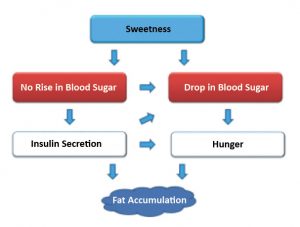By Colin E. Champ, MD, CSCS – Radiation Oncologist
 Sugar substitutes are what many turn to this time of year. For a quick rundown, aspartame, acesulfame, neotame, and saccharin are considered closer to manufactured chemicals when it comes to sweeteners. The sugar alcohols and sucralose are essentially sugars with a chemical added to hinder absorption or block the body’s ability to break it down. They maintain their sweet taste but can pass through us untouched. Erythritol, for instance, gets absorbed into the blood stream from the intestines but leaves the body intact through the kidneys with urine; 10% can get passed into the colon, which can cause a laxative effect. Along these lines, xylitol, maltitol, and some of the other unabsorbed sugar alcohols pass into the bowels undigested, causing potential issues. Stevia is a very popular “natural” sweetener, but that doesn’t necessarily make it a wise option.
Sugar substitutes are what many turn to this time of year. For a quick rundown, aspartame, acesulfame, neotame, and saccharin are considered closer to manufactured chemicals when it comes to sweeteners. The sugar alcohols and sucralose are essentially sugars with a chemical added to hinder absorption or block the body’s ability to break it down. They maintain their sweet taste but can pass through us untouched. Erythritol, for instance, gets absorbed into the blood stream from the intestines but leaves the body intact through the kidneys with urine; 10% can get passed into the colon, which can cause a laxative effect. Along these lines, xylitol, maltitol, and some of the other unabsorbed sugar alcohols pass into the bowels undigested, causing potential issues. Stevia is a very popular “natural” sweetener, but that doesn’t necessarily make it a wise option.
The main reason we use artificial sweeteners is to supply our taste buds and brain with that sweet sensation without the insulin-stimulating and fat-promoting effect of excess sugars and carbohydrates. As described in the figure below, if carbohydrates turn to sugar in our blood and cause the release of insulin to combat this rise in blood glucose, simply removing the carbohydrates – but not the sweetness – will in theory eliminate this problem. In this sense, artificial sweeteners are basically viewed as empty calories; they are not a food, but rather a pleasure-inducing chemical.
Along with regular sugar, many artificial sweeteners are known to increase hunger, cause weight gain, disrupt the microbiome, spike glucose, and create inflammation.
Artificially Feeding Our Addiction
Both sweet foods and addictive drugs stimulate the ventral striatum of our brain via dopamine signaling. This pathway involves both the processing of rewards and learning. Our brain can actually change when we consume pleasurable and addictive substances. For instance, rats that drink a sweet sucrose cocktail for just three weeks experience changes in neuronal activity in the emotion and pleasure center of the brain, known as the limbic area.
Further supporting the connection between the addictive areas our brains and the sweet taste of sugar are studies revealing opioid-like dependence and withdrawal in mice forced to abstain from sugar. Severe withdrawal is experienced by mice provided sweet glucose and then the drug naloxone – the same drug given in the emergency room after heroin overdoses. The similarities to a withdrawing heroin addict are uncanny, interesting, and most of all, frightening.
Perhaps the most alarming study was one where scientists tested the effect of saccharine on morphine tolerance in mice. As a person takes more and more narcotic pain medications, their tolerance generally increases as the body adjusts to the opioid, requiring higher doses for the narcotic to be effective at fighting pain. When mice were given a daily saccharin solution for 28 consecutive days, morphine no longer resulted in its typical analgesia. In other words, the tolerance of opioids in the mice was increased from the sweet taste of saccharine, necessitating larger doses of opioid drugs to achieve similar analgesic effects. The scientists suggested that chronically elevated saccharin intake may cause the release of opioids within our body, resulting in raised tolerance to external morphine. This worrisome finding suggests that saccharin may elicit similar physiologic effects as heroine.
Elimination is Optimal
Artificial sweeteners are bad for your body’s glucose control, offsetting the main reason most people use them instead of sugar and defeating the purpose of using them in the first place. The damage they impart to our bowel bacteria adds fuel to the unhealthy fire of these little packets of chemicals. Acting on our brain much like cocaine or heroin is perhaps the most concerning of all and leaving us craving more sweets afterwards once again defeats the purpose of artificial sweeteners.
If we are turning to sweetened beverages and foods for pleasure, satisfaction, or to deal with stressful and difficult situations, this may signify deeper issues in our lives that need addressed. Turning towards more healthful behaviors for reward, and especially those that provide longstanding gratification, such as taking a walk or hike with friends and loved ones, or weight training instead is rewarding to the brain and body. Exercise stimulates the same reward areas of the brain as these addictive and sweet drugs. Leave the chemicals to science experiments and feed your body the foods that we thrived on for millions of years.
Inspire Exercise Medicine
Inspire Exercise Medicine is focused exclusively on supporting cancer patients on the road to regaining their health with oncologist defined evidence-based treatment plans for nutrition and exercise in support of their overall health and wellness.
A significant part of the Inspire Exercise Medicine space is dedicated to physical, monitored exercises on machines and with exercise equipment, specifically selected for treatment purposes.
239.429.0800
InspireExerciseMedicine.com
3555 Kraft Road, Suite 130
Naples, FL 34105
Dr. Colin Champ, MD, CSCS
Dr. Colin Champ, MD, is a radiation oncologist with board certifications in radiation oncology and integrative and holistic medicine. Dr. Champ’s research interests include the prevention and treatment of cancer with lifestyle modification, including exercise and dietary modification
Source:








